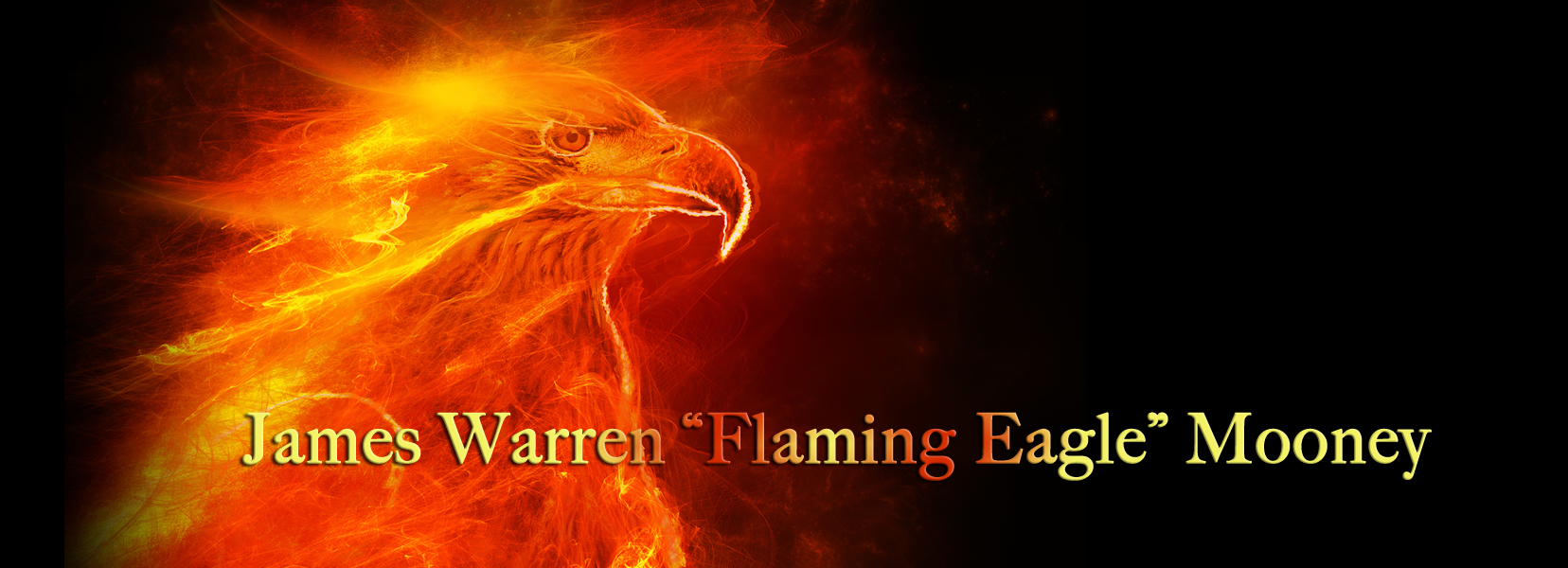The Stand to Preserve the Native American Indigenous Spiritual Culture
The Stand to Preserve the Native American Indigenous Spiritual Culture
From the moment the first European settlers set foot on the North American continent, the lives, culture, and spirituality of the Native American’s indigenous culture has been systematically attacked with four atrocities. The four atrocities perpetuated against the Native Americans are: extermination order, cultural genocide, denial of civil liberties, and character assassination. Treaties were made and broken, however the Native American culture and spirituality are still here, and those treaties are still valid and in effect, even though the states didn’t honor them.
Three men have made valiant stands for the preservation of the Native American culture and its spirituality and in overcoming the four atrocities: Seminole War Chief and medicine man Osceola, James Mooney, Smithsonian ethnographer, and James “Flaming Eagle” Mooney, great-great grandson of Osceola and great-grandson of James Mooney, has won legal battles ensuring the rights of members of the Native American Church who sit in bone fide Native American ceremonies to worship with sacred medicines and experience the full ramification of the U.S. Constitution.
Seminole War Chief and Medicine Man, Osceola
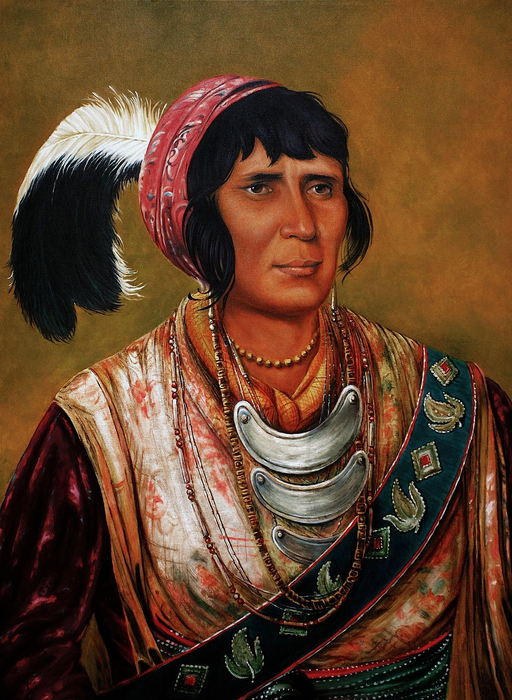 In Florida, one Seminole war chief and medicine man led the way against the U.S. Army and government. Osceola, also known as Billy Powell, was born around 1804 in what Alabama is now, but he became most famous for his role in the resistance against the forced removal of the Seminole people from their ancestral lands in Florida. The Seminole tribe was a unique amalgamation of Native American and African American cultures due to interactions and intermarriages over the years.
In Florida, one Seminole war chief and medicine man led the way against the U.S. Army and government. Osceola, also known as Billy Powell, was born around 1804 in what Alabama is now, but he became most famous for his role in the resistance against the forced removal of the Seminole people from their ancestral lands in Florida. The Seminole tribe was a unique amalgamation of Native American and African American cultures due to interactions and intermarriages over the years.
Osceola’s leadership and charisma made him a central figure in the resistance against the Indian Removal policies of the U.S. government, particularly the enforcement of the Indian Removal Act of 1830. This policy aimed to relocate Native American tribes to lands west of the Mississippi River, thus stealing their ancestral lands for European settlement.
The Indian Removal Act of 1830, signed by President Andrew Jackson, posed the greatest threat to Osceola’s desire for Seminole autonomy. Between 1832 and 1838, this federal legislation directed the deportation of the Cherokee, Creek, Choctaw, Chickasaw, and Seminole tribes west of the Mississippi River to Indian Territory, which is present-day Oklahoma.
The Supreme Court, led by Chief Justice John Marshall, ruled that the state of Georgia’s laws had no jurisdiction over the Cherokee Nation’s territory, thus making the Indian Removal Act unconstitutional. Nevertheless, President Jackson defied the Supreme Court, and emboldened the state governments to proceed with removal policies, eventually leading to the Trail of Tears.
Prior to the Supreme Court’s ruling, The Treaty of Payne’s Landing was negotiated with some of the Seminole leaders and the federal government, but it faced opposition from Osceola and many other Seminole people who did not agree with the terms of the treaty. Osceola emerged as the leader during this time and was vocal in his opposition to the forced removal. He refused to give up his culture and his spirituality and be associated with a treaty that would likely be broken. Legend has it that Osceola was so upset by this treaty, he stuck a knife through it.
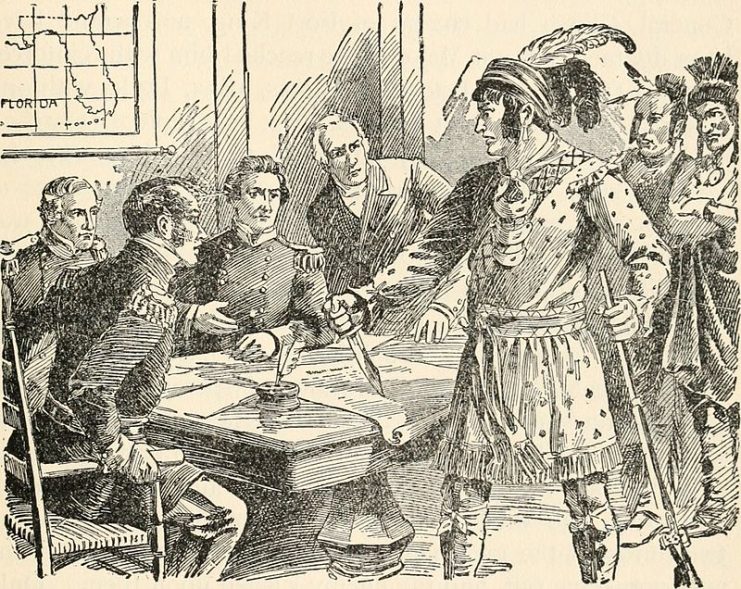
Etching of Osceola purportedly stabbing the treaty with his knife.
Osceola’s refusal to sign the Treaty of Payne’s Landing and his subsequent leadership in resisting the forced removal contributed to the outbreak of the Second Seminole War, which lasted from 1835 to 1842. Their refusal to leave their lands led to a protracted guerrilla war between the Seminoles and the U.S. military. Osceola was trained at West Point, so was well versed in the military tactics of the U.S. military. The Seminoles used their knowledge of the Florida terrain to their advantage, making it difficult for U.S. forces to capture them. The conflict officially ended in 1842, although some Seminoles managed to evade capture and remain in Florida. One of these groups was the Oklevueha Band of the Seminoles.
In October 1837, Osceola was lured into a meeting under a flag of truce by U.S. officials, who were hoping to negotiate a peace settlement. However, this meeting was a ruse, and Osceola was captured by U.S. troops. His capture was a significant blow to the Seminole resistance movement and began the process of Congress defunding the war.
After his capture, Osceola was imprisoned at Fort Moultrie in South Carolina. He and other captured Seminole leaders were subjected to difficult living conditions and suffered from illness. Osceola’s health deteriorated, and he reportedly suffered from respiratory issues, which were exacerbated by the harsh conditions of his captivity.
On January 30, 1838, Osceola died in captivity at Fort Moultrie. The exact cause of his death is disputed. While some accounts suggest that he died from complications related to his respiratory illness, others claim that he was poisoned. Regardless of the exact cause, Osceola’s death was a significant event during the Second Seminole War.
James Mooney, American Ethnographer, Anthropologist, and Folklorist
 James Mooney was an American ethnographer and anthropologist born on February 10, 1861, in Richmond, Indiana. He grew up in Indianapolis and developed an early interest in the cultures of Indigenous peoples, particularly Native American tribes. Mooney pursued his passion for anthropology and ethnography, and his work would later become pivotal in the study and preservation of Native American cultures. He understood that the Native Americans are deeply connected to all things in a spiritual manner. The Native American culture is inextricably connected to their spirituality and cannot be separated. James Mooney understood that by protecting the Native American spiritual practices the entire culture could be preserved and protected.
James Mooney was an American ethnographer and anthropologist born on February 10, 1861, in Richmond, Indiana. He grew up in Indianapolis and developed an early interest in the cultures of Indigenous peoples, particularly Native American tribes. Mooney pursued his passion for anthropology and ethnography, and his work would later become pivotal in the study and preservation of Native American cultures. He understood that the Native Americans are deeply connected to all things in a spiritual manner. The Native American culture is inextricably connected to their spirituality and cannot be separated. James Mooney understood that by protecting the Native American spiritual practices the entire culture could be preserved and protected.
Mooney’s career as an ethnographer began in the late 1880s when he joined the Bureau of American Ethnology (BAE), which was part of the Smithsonian Institution. He conducted extensive fieldwork, living among Native American tribes from the east to west coast to study their customs, languages, and religious practices. One of his most significant works was his research on the Cherokee people. Mooney lived with the Cherokee for several years, learning their language and documenting their sacred rituals and myths. His thorough understanding of the Cherokee culture led to the publication of “The Sacred Formulas of the Cherokees” in 1891, which remains a valuable resource for understanding Cherokee religious practices. Mooney published nine books about the Native Americans, including some of the most detailed early research into peyote.
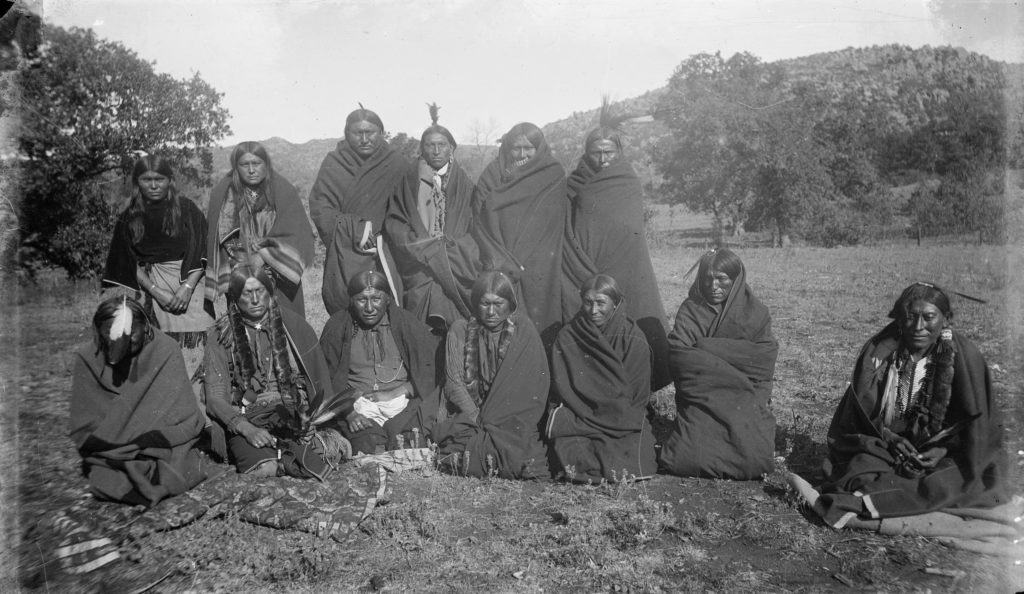
Peyote Ceremony by James Mooney, 1893. Courtesy of the National Anthropological Archives, Smithsonian Institution (gelatin glass negative BAE GN 01778a 06305400).
In the 1890s, James Mooney, spent time with the Kiowa in Oklahoma, researching the spiritual use of peyote. Noting the political trends to prevent the Native Americans from exercising their spiritual practices, he advised peyotists of various Oklahoma tribes to obtain a legal charter to protect their religious freedom. Mooney, with the input of the various tribal leaders, wrote the by-laws and incorporation papers of the Native American Church on October 10, 1918 , thus establishing the legality and protection for the sacred ceremonies and medicines, especially the ceremonial use of peyote. Through this legal recognition, the Native American Church has been able to protect its religious freedom and cultural heritage, despite ongoing legal challenges and efforts to restrict the use of peyote in some areas. At this time, Congress was quite concerned about the use of peyote, and over nine bills were introduced between 1916 and 1937. James Mooney went back to Washington to argue before the House Subcommittee on Indian Affairs in support of the peyote religion. Mooney was able to successfully argue against these bills, and none of them were ever made into law
However, Mooney’s work was criticized by some Indigenous activists, scholars, and descendants for what they perceived as a lack of understanding and for presenting a skewed perspective. Critics were so incensed by his work to protect peyote, that they went to Washington and insisted he be removed from his position at the Smithsonian. There was an attempt to malign his name and all the good works he had done. As a result, James Mooney’s writings and his works have been removed from the public and are only accessible through special permission. He was prevented from continuing his research into the Native Americans, and he died a broken man.
James “Flaming Eagle” Mooney, Elder Seminole Medicine Man
 James “Flaming Eagle” Mooney has worked to ensure that the civil liberties of all Native Americans are protected and available to all. Living most of his life without the conscious knowledge that he was Native American, James Mooney was awakened one night out of a deep sleep by a phone call from his Tribal Chief calling him home to the medicine. This call initiated years of study, travel, and sitting with medicine people from all over the world. James began an intense study of the various ceremonies and a deep dive into the world of healing through peyote. However, not everyone supported James in his role as medicine man and Native American.
James “Flaming Eagle” Mooney has worked to ensure that the civil liberties of all Native Americans are protected and available to all. Living most of his life without the conscious knowledge that he was Native American, James Mooney was awakened one night out of a deep sleep by a phone call from his Tribal Chief calling him home to the medicine. This call initiated years of study, travel, and sitting with medicine people from all over the world. James began an intense study of the various ceremonies and a deep dive into the world of healing through peyote. However, not everyone supported James in his role as medicine man and Native American.
From working in the prison system in Utah, to the raid on his home and his arrest, James “Flaming Eagle” Mooney has been a target for those who wish to continue working against the Native Americans. James believes there has been an ongoing conspiracy begun in our government and cascading to churches and educational systems to prevent the Native Americans from living their lives, their culture, and their spiritual practices in the manner they desire.
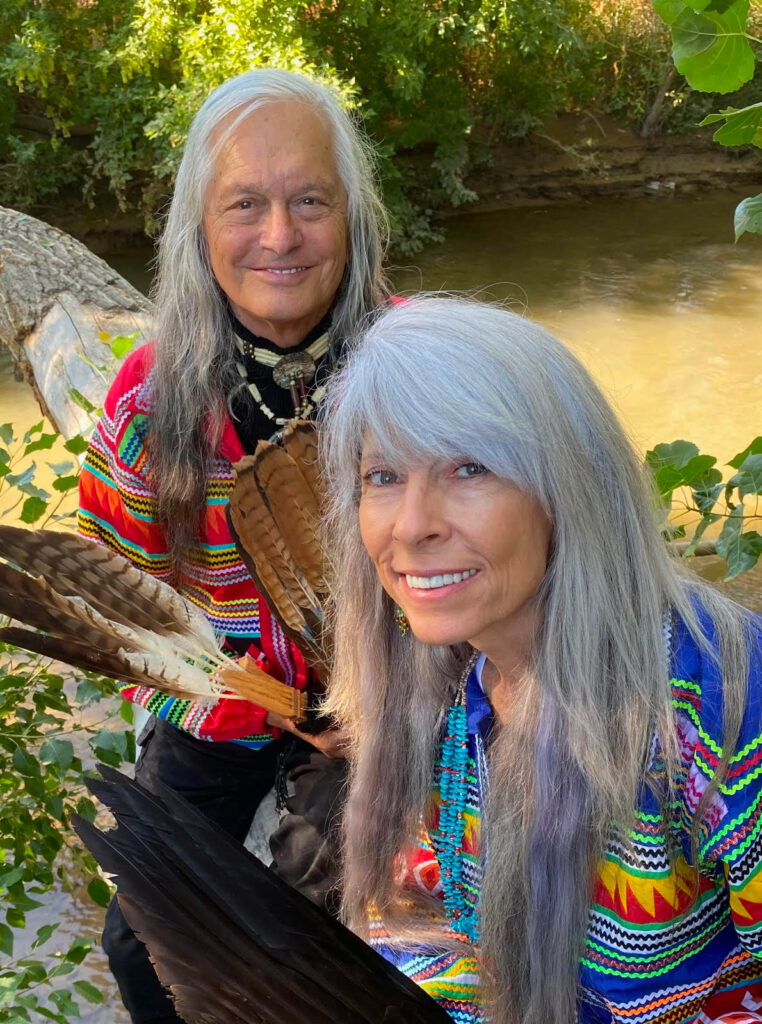
James and Linda Mooney
James Mooney and his wife, Linda, successfully stood against drug, racketeering, and fraud charges brought against them by the State of Utah and the US Federal Government. The state accused them of providing drugs, i.e., peyote, to non-Indians and Indians that were not tribal members. The Federal case took the whole situation much further calling into question James’ heritage and stories about his training, relying on lies, false statements, and the interference of NARF into the proceedings. The various agencies went to great lengths to lie, distort truth, and even redact testimonials supporting James and Linda Mooney. The state and federal governments knew the only way they could “win” was to have the Mooneys plea bargain. To that end, they threatened to take their children away, called James the “Jim Jones of Indians,” and required them to take frequent drug tests, with the understanding that if they missed any of them, they would be arrested again. Of course, one of the tests went missing, but fortunately the Mooneys had a receipt from the drug test center.
Because of the many blessings from Indian elders, and the confirmation that James was indeed who he said he was, the Mooney’s case was dismissed by the Utah Supreme Court prior to evidential hearing. James believes winning this case was the fulfillment of James Mooney’s prophecy that Indians would be able to experience the full ramifications of their constitutional rights.
James has stood as an outspoken advocate for civil rights for all humans. He has been recognized for his work in law enforcement, in the prison systems, as a member the Priory of Indigenous People, Hospitaller Order of Saint Lazarus of Jerusalem, participated in the United Nations Declaration on the Rights of Indigenous People, and has been recognized by Utah Governors Leavitt, Herbert and Cox, along with President Obama.
Two ancestors and one man, worked over generations to preserve and protect the rights of the Native Americans and overcome the four atrocities. These three men represent the how the four atrocities were systematically put upon them, and how they overcame them. Osceola faced extermination and fought those edicts with war. James Mooney worked to protect the Native Americans from cultural genocide. The government worked very hard to make the culture, the ceremonies, even the herbal medicines used by the tribes illegal, ultimately to destroy and eliminate the native culture. James Mooney recognized what was happening and worked quickly to write the charter for the Native American Church, thus codifying and protecting their spirituality through the creation of a government approved church. James and Linda Mooney overcame and survived the character assassination and the attempted subversion of their civil rights and won the right for all humans to be able to sit in sacred ceremony and partake of Creator’s medicines and to experience the full ramifications of the U.S. Constitution.
